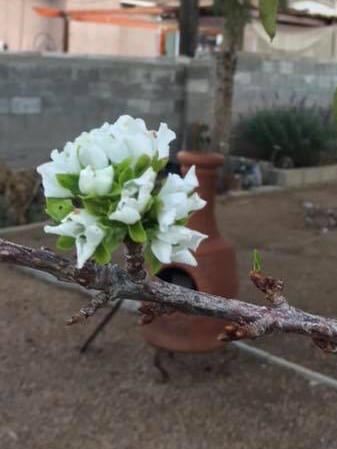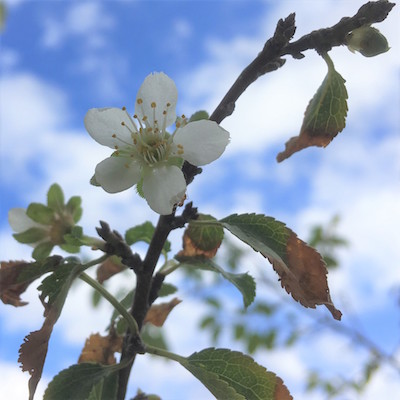 Ranier cherry blossoms in Albuquerque at the end of September. Photo credit Stacia G.
Ranier cherry blossoms in Albuquerque at the end of September. Photo credit Stacia G.
Question: Do you know why my Ranier cherry tree is blooming now (September 30)? It doesn’t look so good, but earlier this year it produced a decent amount of cherries. - Stacia G., Albuquerque, NM
Answer: I came across Stacia’s question on a gardening Facebook page with photos of her flowering cherry tree. Fellow plant-loving Facebooker and grower in Edgewood, Ken Koger, provided a great response post: “Very common on fruit trees that have been stressed from lack of water. They basically go into a semi-dormant state, and then when monsoons hit with suddenly lower temps, water to the roots, and higher humidity they come out of the dormant state and first thing they do is bloom, just like in spring.” Koger went on to recommend watering deeper and out beyond the small tree’s dripline, where the majority of the hard-working, water absorbing roots are expected to grow. He also suggested a fat layer of wood-chip mulch, which made me happy as a clam.
Other group members started chiming in that their fruit trees were also blooming. A pear here. An apple there. And my interest was piqued. Weeks went by as I wrote about soil amendments, deadheading flowers, and how to deal with extra green tomatoes. Last week I saw an NPR headline that practically jumped off my screen: “In Japan, A Strange Sight: Cherry Blossoms Blooming in the Fall.” In this short article, Laurel Wamsley describes a situation in which hundreds of people have reported blooming cherry trees all over Japan. It is suggested that this phenomenon was spurred by typhoons that occurred just weeks before. The stress from being defoliated by wind combined with salt sprays and warm temperatures may have shocked these trees into bloom.
 Plum tree blooming in mid-October in Truth or Consequences. Photo credit Jeannie O.Since I read that article, I’ve gotten calls from NMSU Otero County Extension Agent, Sid Gordon, about peaches that are just barely ripening in High Rolls, and from a friend in Truth or Consequences with a plum tree bearing fresh flowers.
Plum tree blooming in mid-October in Truth or Consequences. Photo credit Jeannie O.Since I read that article, I’ve gotten calls from NMSU Otero County Extension Agent, Sid Gordon, about peaches that are just barely ripening in High Rolls, and from a friend in Truth or Consequences with a plum tree bearing fresh flowers.
I was reminded of the pomegranate tree we had growing up on Sullivan’s Island, SC. My dad said it grew for years without a single flower until September 21, 1989, when the storm surge from Hurricane Hugo flooded the yard 7 feet deep in salt water. By that Christmas, it was bursting with blooms.
All of this led me to wonder, are we talking about late bloomers leftover from this past spring/summer? Or are these precocious flowers that are popping out several months early? I also wondered if all plants occasionally bloom out of whack. Is this just a New Mexico and Japan thing?
I searched the Southwest Yard & Garden archives for this topic and found a goodie by Dr. Curtis Smith back in the fall of 2008: “I have had several calls about fruit trees blooming this fall (late summer) from several parts of New Mexico. It is not unheard of and something that I remember from my youth in southeast Texas (so this is not a uniquely New Mexico occurrence).”
I called NMSU Extension Pecan Specialist, Dr. Richard Heerema, and asked: “Do people ever report pecan trees blooming in the fall?” He pointed out that pecan trees have separate male and female flowers located on the same plant, but in different spots along a given branch, and said he may have heard of male flowering structures (aka catkins) blooming way late, but not female flowers. Of course, the female flowers are harder to see than a cherry or apple blossom, even in the spring. Female pecan flowers lack petals and can be as small and unattractive looking as a peppercorn.
When I asked how to tell if a cherry flower is blooming 6 months late or 6 months early, Heerema said it all comes down to the bearing habit of any particular species or cultivar. Many trees, like cherries, peaches, persimmons, and pistachios, tend to bear flowers (and fruit, if we’re lucky) laterally on one-year-old shoots. It quickly gets complicated with spurs, which are modified shoots found on lots of fruit trees, but I’m almost out of room, so we’ll save the fruiting spur discussion for another week.
It’s hard to tell for sure from the photo in the original cherry blossom question if the flowers are borne on the portion of the spur that developed this summer or on growth from the 2017 season. If we looked closely at the peaches in Otero County, I’m betting we’d find that they’re growing on older wood and are therefore just late bloomers—more specifically, late ripeners. In the photo of plum flowers, that bud barely about to open in the far top right corner looks like it is borne on new growth, so we can guess that it is blooming 6 months early. Those plum buds were likely already dormant or nearing dormancy when a combination of environmental cues (like temperature fluctuations and monsoons) triggered them to develop way ahead of schedule.
For most fruit trees, including cherries, peaches, and plums, the “decision” to produce flowers is made a whole season ahead of time. That is, the 2019 flowers are already ready to go in the buds on your trees right now. If you were to dissect the buds, you’d see minuscule flower parts (floral primordia) already in there, waiting patiently, or not-so-patiently.
Visit my blog here for a cool time-lapse video of almond floral organogenesis under a scanning electron microscope, more details from Ken Koger, the NPR article on Japanese cherry blossoms, Curtis Smith’s full response from 2008, and a link to several Facebook pages I follow with glee.
Send gardening questions to Southwest Yard and Garden - Attn: Dr. Marisa Thompson at desertblooms@nmsu.edu.
Please copy your County Extension Agent here and indicate your county of residence when you submit your question!
For more gardening information, visit the NMSU Extension Horticulture page at Desert Blooms here and the NMSU Horticulture Publications page at here.
Marisa Y. Thompson, PhD, is the Extension Horticulture Specialist, in the Department of Extension Plant Sciences at the New Mexico State University Los Lunas Agricultural Science Center, office: 505- 865-7340, ext. 113.